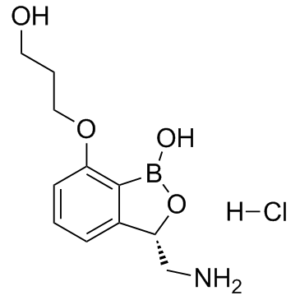Epetraborole hydrochloride (also known as GSK2251052 hydrochloride and AN3365 hydrochloride) is a novel, potent and selective leucyl-tRNA synthetase (LeuRS) inhibitor, which inhibits protein synthesis by binding to the terminal adenosine ribose (A76) of leucyl-tRNA synthetase. Epetraborole was under investigation for the treatment of infections caused by multidrug-resistant Gram-negative pathogens. GSK2251052 is a novel boron-containing antibiotic that inhibits bacterial leucyl tRNA synthetase. All Clostridium perfringens strains had GSK2251052 MICs of >32 μg/ml.
Physicochemical Properties
| Molecular Formula | C11H17BCLNO4 |
| Molecular Weight | 273.5210 |
| Exact Mass | 273.093 |
| Elemental Analysis | C, 48.30; H, 6.26; B, 3.95; Cl, 12.96; N, 5.12; O, 23.40 |
| CAS # | 1234563-16-6 |
| Related CAS # | 1234563-16-6 (HCl);1093643-37-8;1234563-15-5 (R-mandelate); |
| PubChem CID | 52918389 |
| Appearance | White to off-white solid powder |
| Hydrogen Bond Donor Count | 4 |
| Hydrogen Bond Acceptor Count | 5 |
| Rotatable Bond Count | 5 |
| Heavy Atom Count | 18 |
| Complexity | 244 |
| Defined Atom Stereocenter Count | 1 |
| SMILES | Cl[H].O1B(C2C(=C([H])C([H])=C([H])C=2[C@@]1([H])C([H])([H])N([H])[H])OC([H])([H])C([H])([H])C([H])([H])O[H])O[H] |
| InChi Key | DADYQGIQOBJGIW-HNCPQSOCSA-N |
| InChi Code | InChI=1S/C11H16BNO4.ClH/c13-7-10-8-3-1-4-9(16-6-2-5-14)11(8)12(15)17-10;/h1,3-4,10,14-15H,2,5-7,13H2;1H/t10-;/m1./s1 |
| Chemical Name | (S)-3-(Aminomethyl)-7-(3-hydroxypropoxy)-1-hydroxy-1,3-dihydro-2,1-benzoxaborole hydrochloride |
| Synonyms | Epetraborole hydrochloride; GSK-2251052; GSK 2251052; GSK2251052; AN3365; AN 3365; AN-3365; GSK-052; GSK 052; GSK052; |
| HS Tariff Code | 2934.99.9001 |
| Storage |
Powder-20°C 3 years 4°C 2 years In solvent -80°C 6 months -20°C 1 month Note: Please store this product in a sealed and protected environment, avoid exposure to moisture. |
| Shipping Condition | Room temperature (This product is stable at ambient temperature for a few days during ordinary shipping and time spent in Customs) |
Biological Activity
| Targets | LeuRS(IC50= 0.31 μM) |
| ln Vitro | Key gram-negative aerobic and anaerobic pathogens as well as gram-positive anaerobes are susceptible to the antibacterial action of epetraborole (0-32 μg/mL)[1]. |
| Cell Assay |
Cell Line: Anaerobes isolates Concentration: 0-32 μg/mL Result: revealed MIC50/MIC90 values of 2 and 4 μg/mL for every anaerobe isolate tested. |
| References |
[1]. Comparative in vitro activities of GSK2251052, a novel boron-containing leucyl-tRNA synthetase inhibitor, against 916 anaerobic organisms. Antimicrob Agents Chemother. 2013 May;57(5):2401-4. [2]. Bacterial resistance to leucyl-tRNA synthetase inhibitor GSK2251052 develops during treatment of complicated urinary tract infections. Antimicrob Agents Chemother. 2015 Jan;59(1):289-98. [3]. Sutcliffe JA. Antibiotics in development targeting protein synthesis. Ann N Y Acad Sci. 2011 Dec;1241:122-52. |
Solubility Data
| Solubility (In Vitro) |
DMSO : ~200 mg/mL (~731.21 mM) H2O : ≥ 28 mg/mL (~102.37 mM) |
| Solubility (In Vivo) |
Solubility in Formulation 1: ≥ 2.5 mg/mL (9.14 mM) (saturation unknown) in 5% DMSO + 40% PEG300 + 5% Tween80 + 50% Saline (add these co-solvents sequentially from left to right, and one by one), clear solution. Preparation of saline: Dissolve 0.9 g of sodium chloride in 100 mL ddH₂ O to obtain a clear solution. Solubility in Formulation 2: ≥ 2.5 mg/mL (9.14 mM) (saturation unknown) in 5% DMSO + 95% (20% SBE-β-CD in Saline) (add these co-solvents sequentially from left to right, and one by one), clear solution. Preparation of 20% SBE-β-CD in Saline (4°C,1 week): Dissolve 2 g SBE-β-CD in 10 mL saline to obtain a clear solution. Solubility in Formulation 3: 5% DMSO+40% PEG300+5% Tween-80+50% Saline: ≥ 2.5 mg/mL (9.14 mM) Solubility in Formulation 4: 100 mg/mL (365.60 mM) in PBS (add these co-solvents sequentially from left to right, and one by one), clear solution; with ultrasonication. (Please use freshly prepared in vivo formulations for optimal results.) |
| Preparing Stock Solutions | 1 mg | 5 mg | 10 mg | |
| 1 mM | 3.6560 mL | 18.2802 mL | 36.5604 mL | |
| 5 mM | 0.7312 mL | 3.6560 mL | 7.3121 mL | |
| 10 mM | 0.3656 mL | 1.8280 mL | 3.6560 mL |
